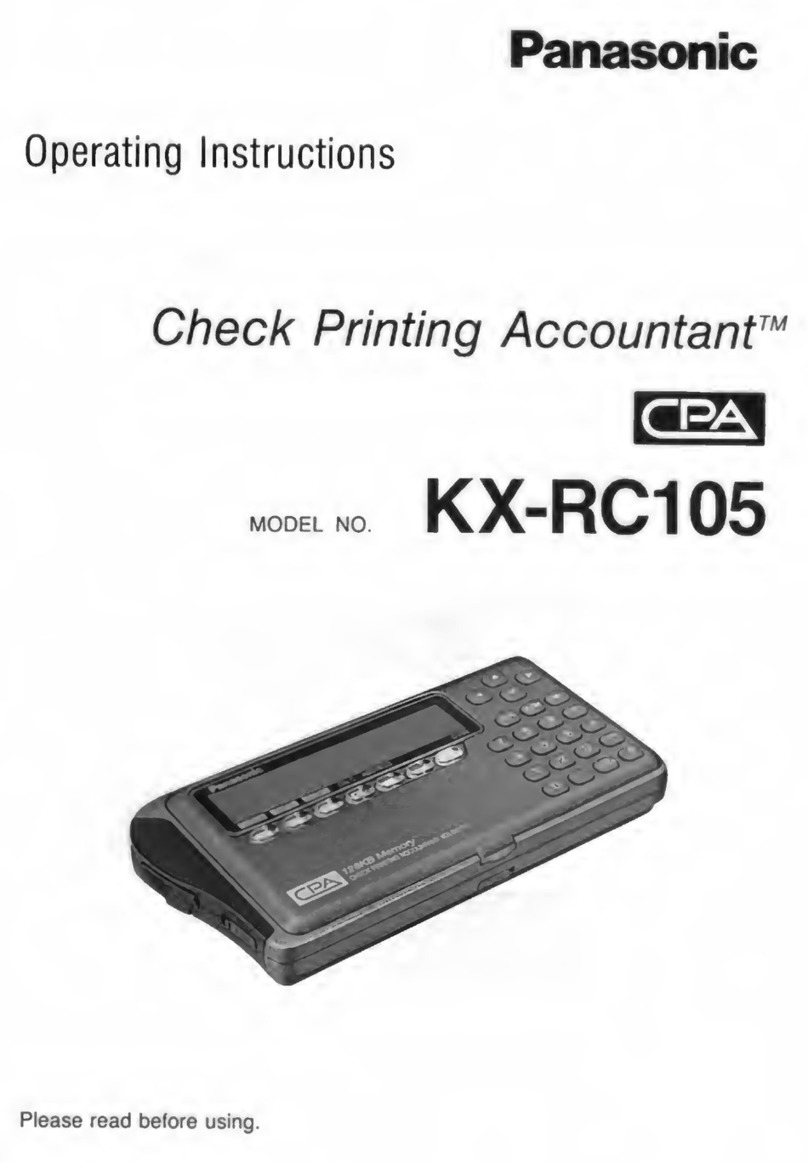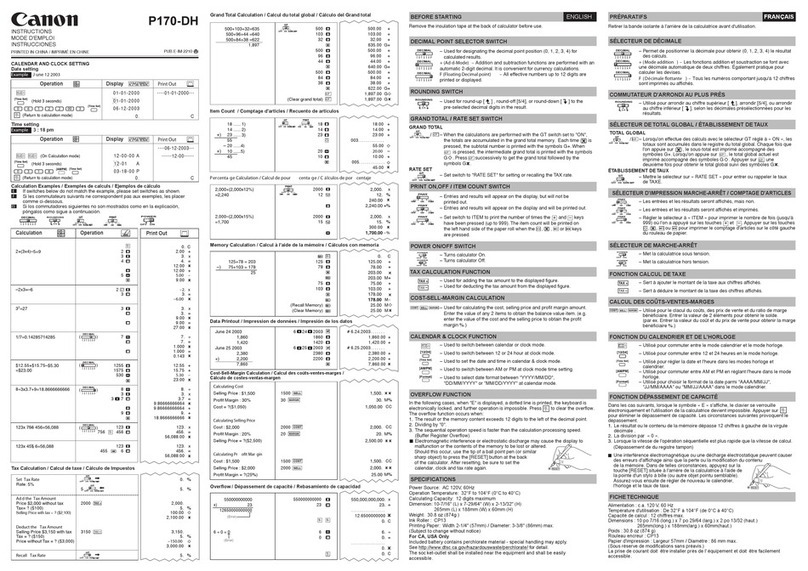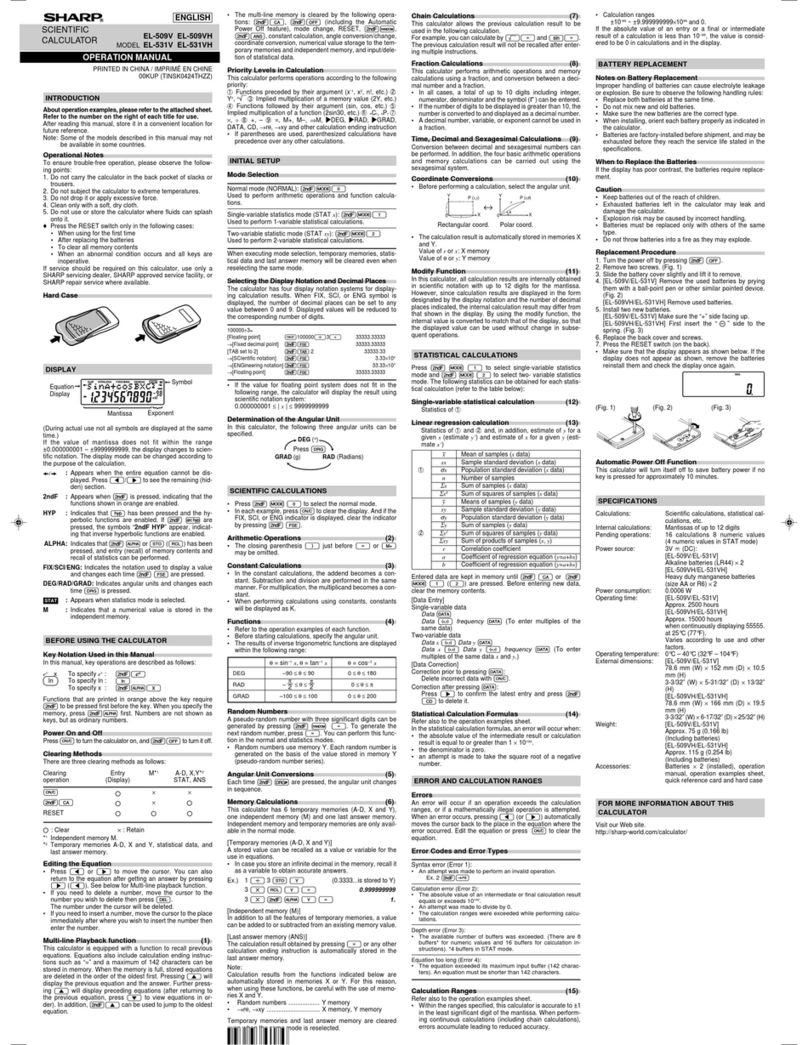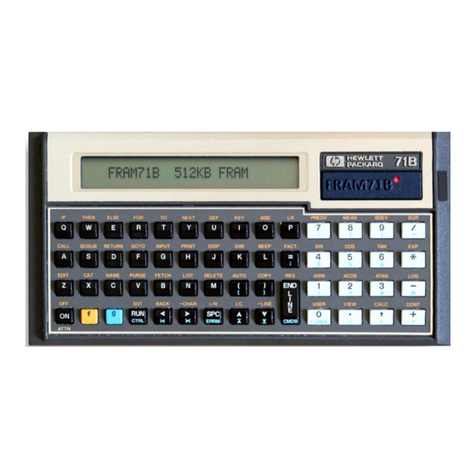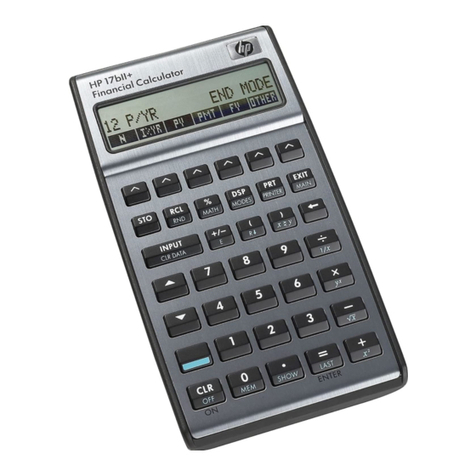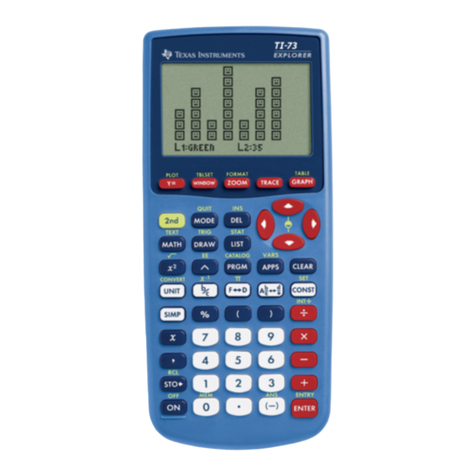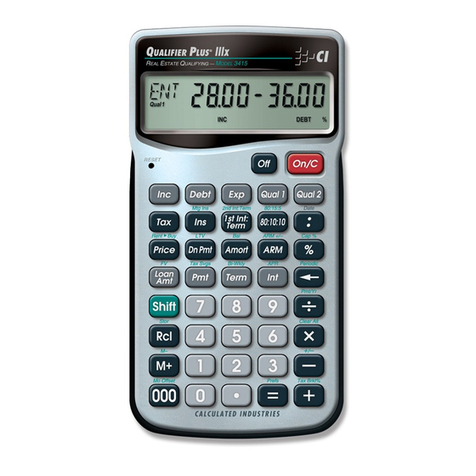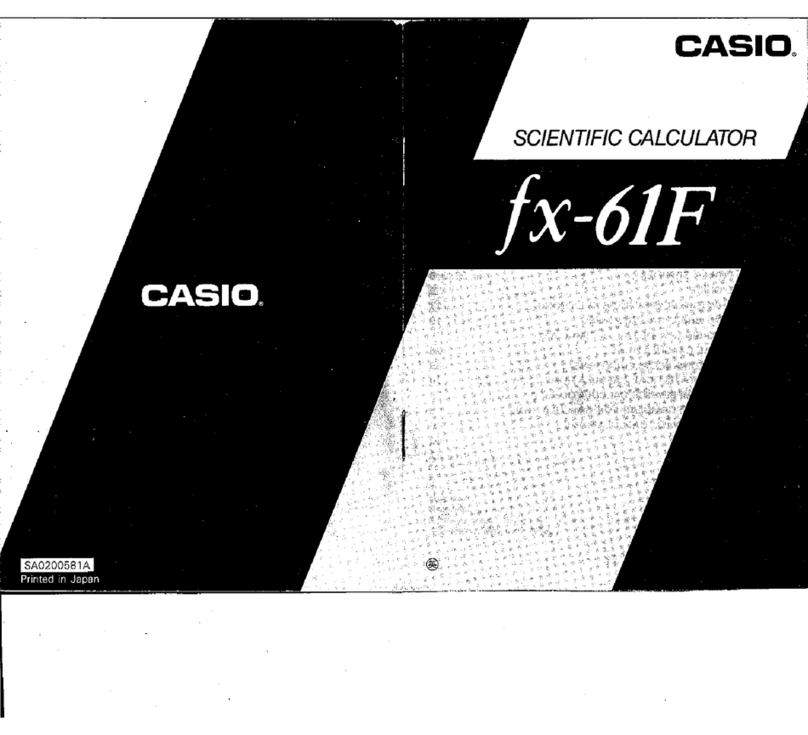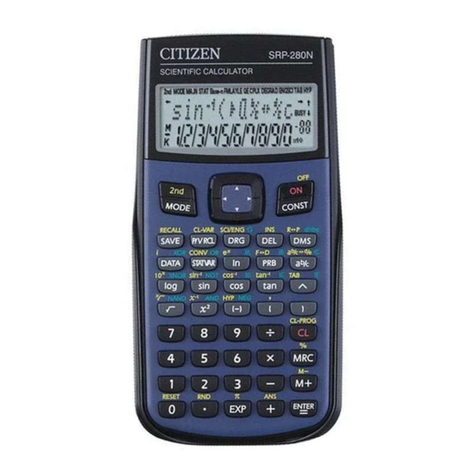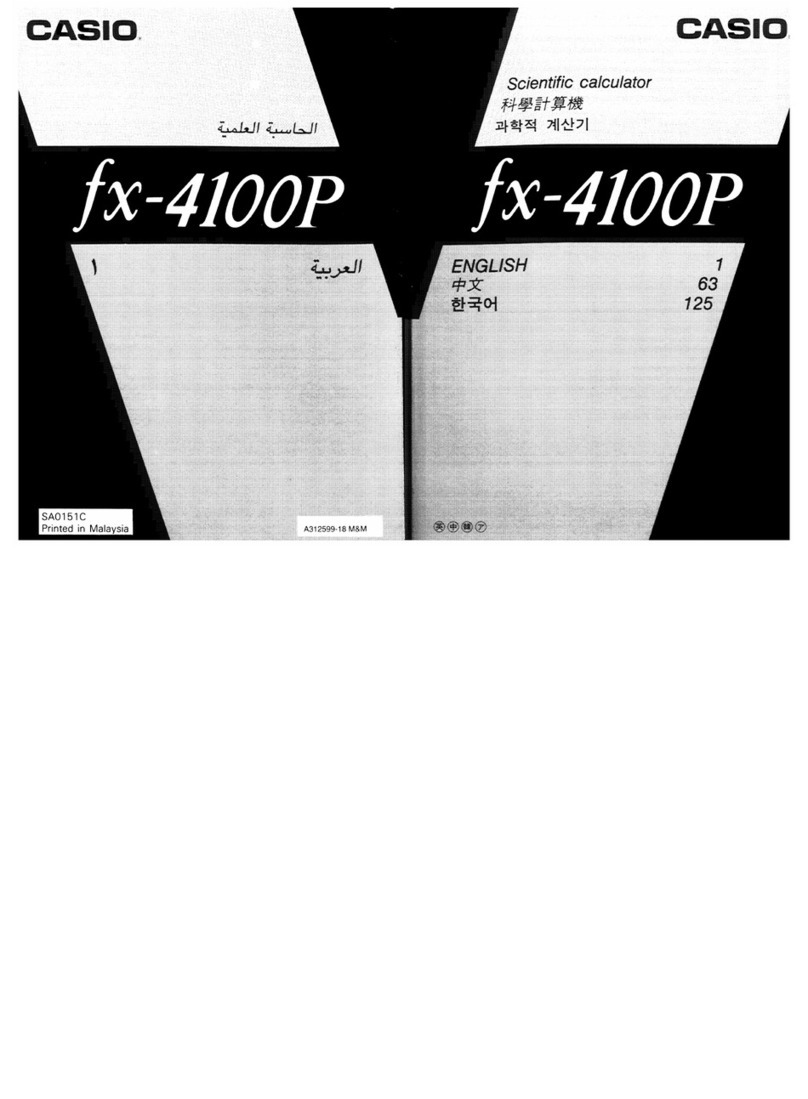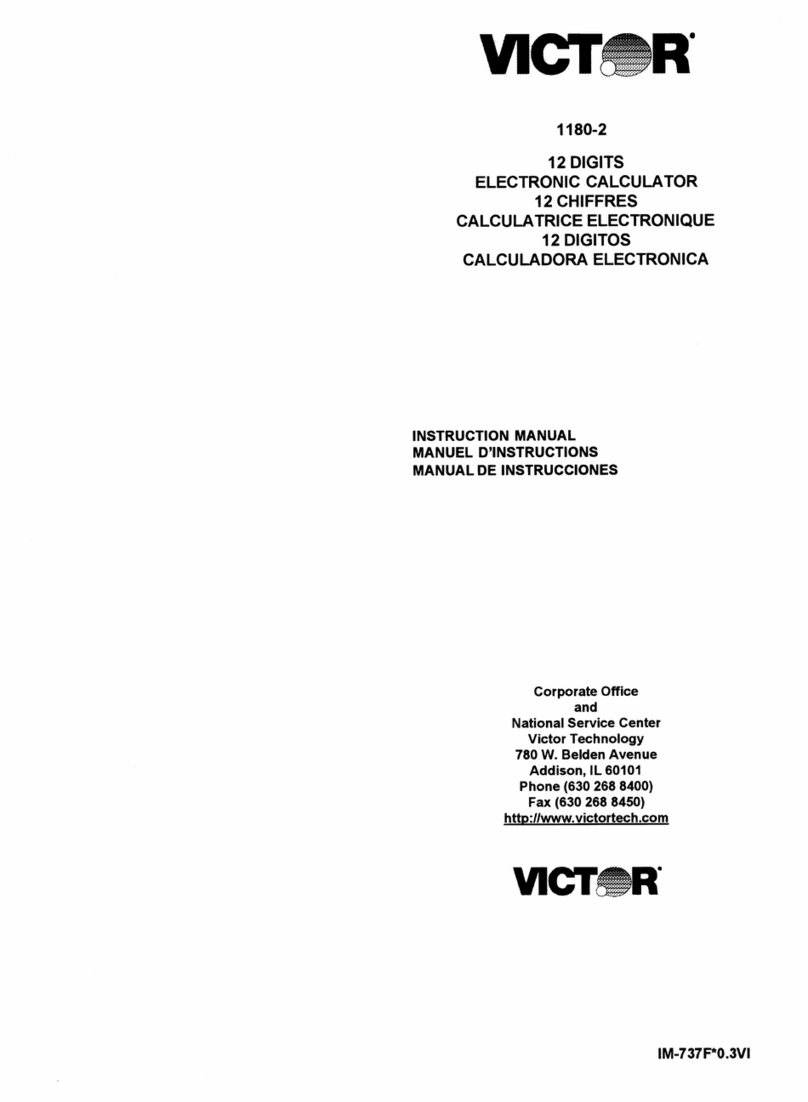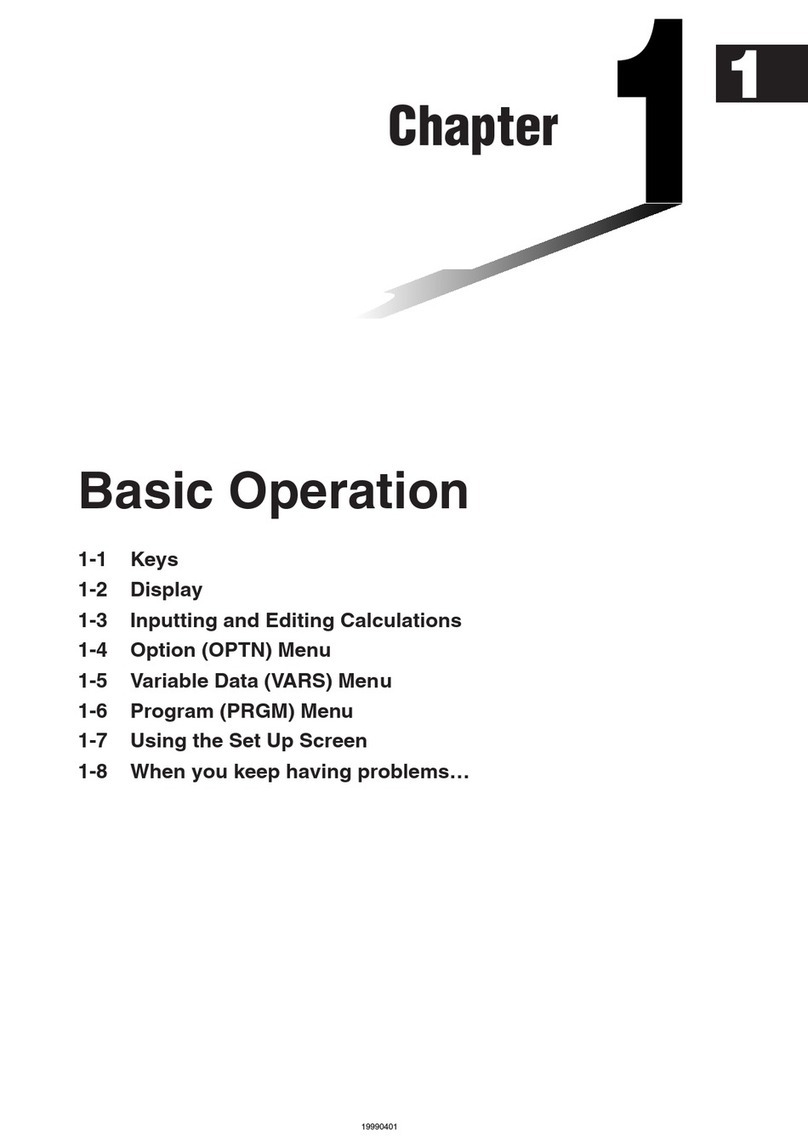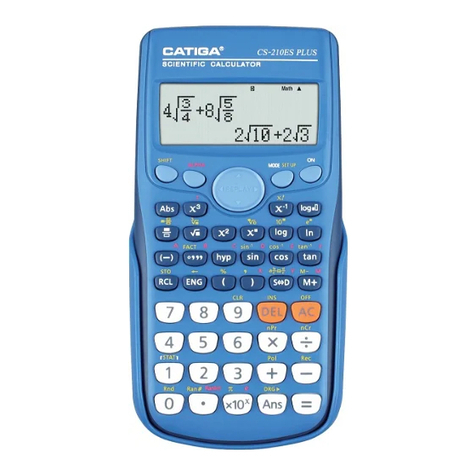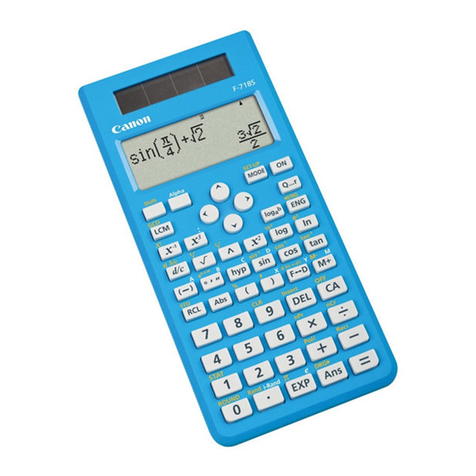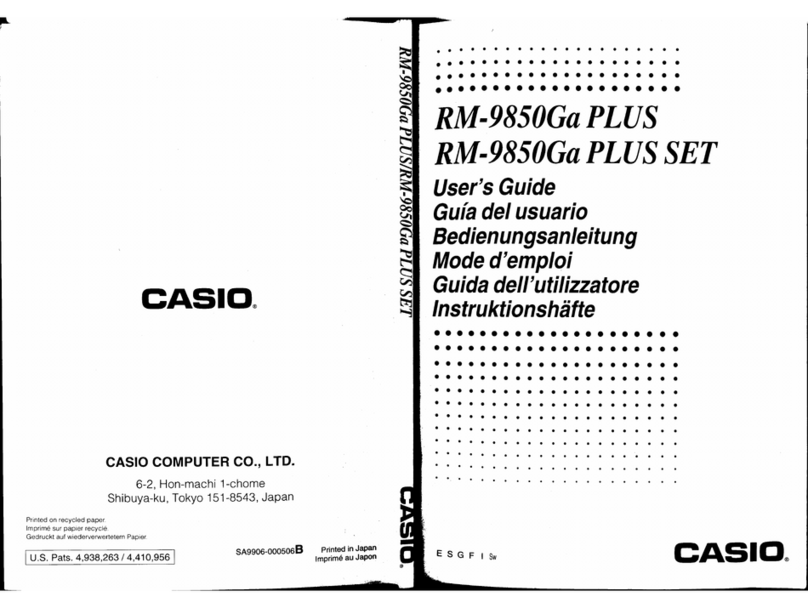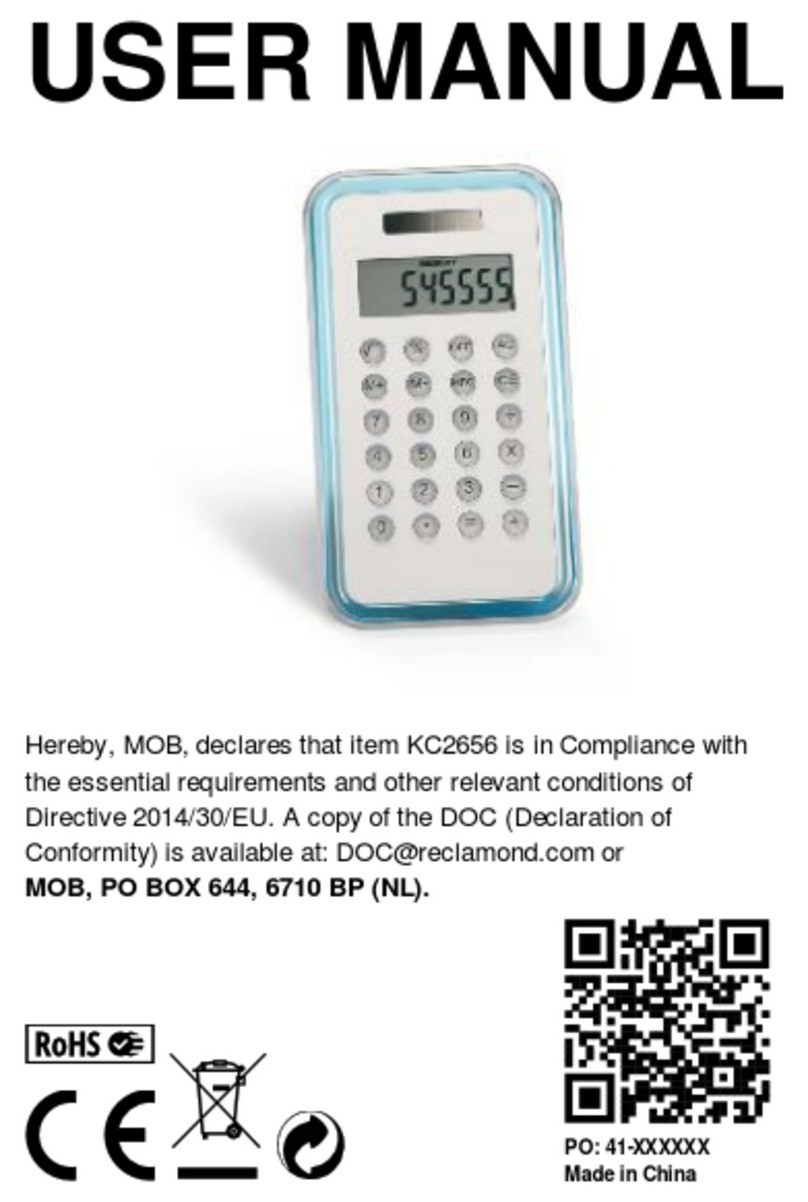Panasonic JE-8401U User manual

Matsushita Electric Trading Co., Ltd.
Trade Center P.O.Box
18
Tokyo
105
.
YLEE76036800
Printed
in
Japan
I,
',
:·
·
.,
'..
. ,
, '
t;
t
..
Electronic Calculator
JE-8401U
I~
Before
operating
this
set.
please
read
these
instructions
completely

Contents
English ......................
...
..
..
..
.
...
.
..
.......
..
.....
...
.....
Spanish ............................................................ 14""' 27
Chinese ...........................................
...
........······28""'
40
Sample Calculations
...
............
..
..
...
..............
41
~
49
.I~
1.
Some important Don'ts
1)
Do
not
use
or
place
this
unit
near so
ur
ces
of
high
temperature,
in high
humidity,
in
di
r
ec
t
sunlight
or
in
dusty
place
for
a
long
time.
It
may
ca
use damage
to
the
cabinet
or
functional
failure
of
the
LSI and
other
components,
and re
sult
in
poor
performance.
2)
Do
not
open
the
cabinet.
If
the
unit
is
defective,
please
contact
your
nearest Panasonic
Electronic
Calculator
service
ce
nt
er.
3)
Do
not
use
thinner,
benzine
or
alcohol
to
clean
the
cabinet. Please use a
silicon·cloth
or
a
cloth
dampened
with
soap and
water
.
4)
Do
not
keep
the
batteri
es
inserted in
the
unit
so
as
to
prevent
leakage
if it
is
operated
with
AC
power
or
unu
sed
at
all
for
a
long
time
(one
month
or
so.)·
2. Main functions
This
model
is
de
si
gned
as
scientific
ca
l
cu
l
ato
r,
claiming
the
following
calculating
functions
.
1)
Di
sp
la
y:
5-digit
mantissa
with
algebraic sign,
2-digit
exponent
with
algebraic sign,
or
8
digit
numeric
with
algebraic sign, and signs.
2)
Number
entry
either
in
floating
point
or
in
scientific
notations.

3) Alget:mriC
operation
for
arithmetic
functions.
4)
Automatic
repeat and
constant
operations
for
arithmetic
functions
and
yX
calculation
5) One
accumulating
memory.
6)
Scientific
functions:
sinx,
cosx,
tanx,
sin-1
x,
cos-1 x, tan-1 x,
eX,
lO
x,
Inx,
logx,
yX,
l/x,..;x;
x2
,rr,
7) Degrees/Radians/
Gradian
s
switch
for
trigonometri
c
functions
.
8)
Chain calculations in
scientific
functions
(except
yX) and D.MS-
operation
in
four
rul
es
!i
:,,
'\
:.
.
3. Before operation
1).
Dry
battery
or
AC
household
line
as
the
power
source.
a)
Dry
Batteries r
Remove
the
battery
cover and insert three
"AA"
size
dry
batteries
to
the
battery
case
in
~
specified (
+)
. (- )
position
. As the
battery
power
nears
exhaustion,
the
display
wil
~
gradually
become
dark,
finally
disappear and
calculations
may
not
be
performed.
!
Replace
the
batteries
with
new ones.
- 2 -
b)
AC
Household
power
line
Use
Panasonic
AC
adaptor
JL-046,
JL-047
(E)
or
JL'()48
(E,
K),
specially designed
for
the
calculator.
Plug
it
in
to
AC
Household
power
Iine and
the
calculator.
Do
not
use
Panasonic
AC
adaptor
JL-026,
JL-027,
JL-028(E)
and
AC
adaptor
of
other
makers.
Disconnect
the
power
cord
of
the
AC
adaptor
from
the
wall
outlet
whenever
the
unit
is
not
in use.
JL-046
:
JL-047
(E):
This
adaptor
is
designed
for
power
sources
of
120V.
This
adaptor
is
for
power
sources
of
115V
(11
OV-120V)
and/or
230V
(220V-24QV)
by
selector
switch.
Please set
the
switch
correctly
at
your
local voltage
before
connecting
the
unit
to
mains
power.
JL-048E
(K):
This
adaptor
is
for
power
sources
of
22QV-240V.
JL-048
:
This
adaptor
is
for
power
sources
of
23QV-240V
.
2) Power
switch
Turn
ON
the
power
switch.
Then
"0"
appears
at
the
first
digit
from
right
in
the
display.
The
unit
is
ready
for
ca
lculations.
- 3 -

,1;;:'
,j
3)
Display
'
\'~
The
display
has
nine
digit
s display tubes
under
two
way
dispfay
methods.
One
is
8
d
ig
its
"
~
numeric
with
algebraic sign,
overflow
sign,
memory
occupied sign and
function
sign.
The
other
is
5
digits
mantissa
with
algebraic
si
gn and 2
digits
exp
one
nt
with
algebraic sign
(exponent
display).
In
the
exponent
display,
the
left-most
position
is
used
to
display
the
algebraic sign
of
the
mantissa,
overflow
sign,
memory
occupied sign and
function
sign.
The
next
5
position
to
the
right
are used
to
display
the
mantis
sa
.
The
tw
o
right
-
most
positions
display
the
exponent.
The
position
between
the
mantissa and ex
pon
e
nt
will
di
sp-
lay
the
minus
exponent
sign.
(Example
: When
the
display
is
-1
.
2300
-
04,
this
means
-1..23x10-
4.)
The
calculated
result
wi
ll be
displayed
in
the
following
method.
1. 1 x
10
- 3
~
Ires
ult
I
~
99999999.
or
resu
lt
= 0 ,
..
·
··
· in
floating
dec
imal
point
displ
ay
>-!
'
..
,
t
sign
2.
99999999.
< I
result
lor
Ire
sult
l<
l x
10-
3
..
.......
..
in
mantis
sa
and
eX
POnent display
(exponent
displa
y system)
- 4 -
t
"
Mantissa
Expo
ne
nt
r-----------,\
/
/ ,'- I
-I
-I
1 I
,-
C":
ri
I.
C
':1
-,.:J
:-
..
.'
t t
(
si
gn.)
(Minus
s
ign)
In
case
of
ex
ponent
display
system,
the
decimal
point
app
ea
rs
right
after
the
fir
st
digit
numb
er
of
mantissa.
sign
display:
.'
_.'
Minus
sign
L{
Memory
occupied
sign
Sf Result
overflow
sign
, .
Function
sign
L)
. (This sign appears
when
F key is pushed)
4)
Number
entry
. 5 d" f
Max
imum
8
digits
number
in
floating
decimal
point
display.
ma
·x
lmum
Iglts 0
manti
s
sa
and 2
digit
s
of
exponent
can be entered
in
exponent
display
. Ex
ponent
numbers
can be entered
when
the
number
keys are depressed
after
EE
key,
and are
effective
in
two
digits
last entered.
If
more
than
6
digits
number
entered
In
the
display,
the
EE key
fun
ct
ion
is
not
effective.
- 5 -

4.
Key
and
Switch functions
1) Numerals key
(0-9)
Sets
the
figure.
2) Decimal
point
key
(.)
Sets
the
decimal
point
.
3) Clear
entry/Clear
key
(
"c
E)
During
number
entry,
a depression
of
the
CE/C
key
will
perform
a clear
entry
function.
The
cleared
entry
number
may
be
replaced
by
a
following
number
entry.
Function
mode
(F) and
overflow
condition
will
also be reset. When
the
CE/C
key
is
depressed
twice,
all
calculation
and entries
will
be
cleared except
memory
contents.
4) Plus key
(+)
Performs
addition.
5)
Minus
key
(-)
Performs
subtraction
.
6)
Multi"plication
key
(x)
Performs
multiplication.
- 6 -
7)
Division
key
(+)
Performs
division
.
8)
Equal
key
(=)
Performs
calculation
or
repeat
calculation
if
the
+,
-,
x,
+
or
yX key
has
been previous-
ly
depressed and the
command
of
such calculations
has
been given.
9)
M~mory
_
e.I':ls
key
(M+)
Accumulates
tl;le
contents
of
display
into
the
memory
store
.
10) Recall
memory
key
(RM)
Re~;;i\~the
-
m~mory~~~t~nts
to
the
display.
11) Clear
memory
key
(CM)
. Clears
the
memory
conte
nts.
12)
Enter
Exponent
key
(EE)
The
EE
key
is
used
to
enter
the
exponent
numbers
during
number
entry.
When
the
EE
key
is
depressed
as
the
first
key
for
number
entry,
then
the
mantissa
is
automatically
made
to
be
1,
and
enter
-
exponent
mode
is
set.
Following
numeral
key depressions enters
a
power-of-ten
exponent
which
shifts
right-to-Ieft
through
the
exponent
digits.
The
last
two
digits
entered
constitute
the
exponent
.
If
the
EE
key
is
not
the
first
key
for
number
- 7 -

entry,
its depression
terminates
the
entry
of
mantissa and also sets
the
enter-expon.
ent
mode.
13)
F
~~y
,
(F)
Its depression calls
the
"e" sign
(Function
sign)
to
the
display
and enables
you
to
start
scie
ntific
calculations
as
in
fun
ct
ion
modes
indicated
above each key.
Two
consecutive
depression relieves F
key
function
.
14)
Trigonometric
function
key (sin, cos, tan)
Performs sine, cosine and
tangent
calculations.
If
F key is depressed
before
this
key,
inverse
trigonometric
(sin-I x,
COS
-I x,
tan
-I
x)
is
performed.
15)
Common
and
Natural
logarithms
key
(log, In)
Performs
common
and natural
logarithms
calculation.
If
F
key
is
depressed before
this
key,
Anti-logarithms
(lOX,
eX)
is
performed.
16)
Square
roo
t
key
(..jX)
Performs
square
root
calculation.
If
F
key
is
depressed
befor
e
this
key,
square
calculation
(X2) is
performed
.
17)
l/x
key
(l/x)
Performs
re
c
iprocal
calculation.
If
F
key
is
depressed
before
this
key
,
performs
entr
y
- 8 -
of
Pi
(3.1415926).
18)
X-M
key
(X-M)
Exchanges
the
displayed
number
with
the
me
mor
y
contents.
19) y
to
the
x
th
pow
er
key(yX)
y
to
the
xt
h
power
calculation
is
performed
if
the
foll
ow
ing
operational
sequence is
observed.
That
is
to
enter
number
for
y, depress yX
key,
enter
number
for
x and
depress =
key
.
If
F key
is
dep
ress
ed
before
this
key,
exchanges
the
displayed
number
with
the
previous
by
entered
number
to
perform
recipro
ca
l
calculation.
20) Sign change
key
(+/-)
Changes
the
sign
of
ent
ered
the
mantissa
or
the
exponent
number.
If
F key
is
depressed
before
this
key,
perf
or
ms Degr
ees
-Minutes-Seconds
to
De
cimal Degree conversion.
21) Degree/
Gradian
/ Radian
mode
s
witch
Selects Degre
e,
Gradian , Radian
mode
for
trigonometric
or
inverse
trigonometric
operation.
- 9
.-

5. Overflow condition
The
following
operations
simulate
the
overflow
condition
and call the
overflow
sign.
In
this
case, depress
CE/C
key
for
resetting.
1)
Basic
four
rules
* I
Calculat
ed
result
l
~
105 0
*
Divided
by
O.
2)
Memory
calculation
" I
Memo
ry
contentsl
~
10
.
50
(In
this
case,
th
e last
calculation
does
not
affect
th
e
memory
register, and
memory
contents
registered
prior
to
the
overflow
are retained.)
3 )
Scientific
calc
ulation
1/x
······
·
··············x
= O, IX 1=
10
-
50
.;x
·
·····
·
····
··
········x
< O
x
"
····
···
··
·
·······
·
······10
25~1
x I
tan
x
····
···
···
····
·····
·
·l0
3
~
Iresultl
sin-Ix,
cos-
lx,
..
···I < Ix I
Inx,
logx··
····
·
··
····
···
x
~
O
eX,
lOx
·
·
·
·
·····
·
···
·····l0
50
~
Iresult I
yx
...........
..
............
y
~
O,10
50~
lresult
I
IJ.
MS-+·····
··
··········· I x 1<6X
I0
-
50
( exce
pt
x = 0 )
-
10
-
.•
6. Automatic constant calculation
Automatic
constant
calculation
can
be
performed
in
all
four
rules and
yX
calculation.
After
calculation
is
completed
with
=
key
being depressed,
the
function
(+,
-,
x,
7,
or
yX)
and
the
last
operator
number
are
automatically
stored
as
a
constant
factor.
Same
type
of
calculation
can be
continued
by
entering
a
new
number
and depressing
the
corresponding
function
key
or
=
key,
as
shown
in sample
calculations.
7. Automatic repeat calculations
Repeat
calculations
can be
performed
in all
four
rules
and
yX
calculation
by
depressing =
key
or
function
key
continuously,
as
shown
in sample
calculations.
8. Calculation range and Accuracy
Fun
c
tion
s
Allowable
range
for
entry
Ac
c
uracy
Basic four rules 10-
50
~
Ixl
<
10
50
±1
in
the
8th
digit
Memory
calculation
(except
overflow
cond
ition)
(±1 in
the
7th
digit
\
yx,
l/x,
Xl,
D.MS
..
in
division
and
l/x
)
-
11
-

Ixl
<
10'
sin x (DEG)
(~
X~~\~
~~~~
.
~:l
..
< Ixl <
180n
+
0.1)
cos x
(DEG)
Ixl
<
10'
(except
89.9
+
180n
< Ix
1<
90.1 +
180n)
Ix l <
10·
tan x (DEG) (except
180n-0.l
<
Ixl<
180n+0
.
l)
88 +
180n
<
Ixl
<
92
+ 1
80n
sino, x,
cos"
x 0.01
~
Ixl
~
0.99
tan" x 0.01
::;
Ixl
<
10
50
In
x,
'Iog
x
10
'50
::;
X < 10
50
(except
0.99
< x < 1.01)
eX
Ixl
~
115.12925
lOX I
xl
< 50
0<
y,
10'50
~
yX
< 10
50
yX
(except
0.99
< y < 1.01)
~
12 -
9.
Specifications
Computing
element:
Power
requirment:
±1 in
the
6th
digi
t •
Memory:
Operating
temperature
:
±1
in
the
6th
digit
Display:
(
'0
<h'
"po",o
. )
display,±l
inthe
5th
digit
of
ma
ntissa.
Calculating
speed:
Dimensions:
Weight:
MOS/LSI
AC
:
120V±10%
(JL
·
046),
11
0-120/220-240V±1
0%
(JL·047(E)),
230-240V±10%
(JL
·
048),
220-240V±1001o
(J
L
·048E
(K))
50/60
Hz.
(Through
optional
AC
adaptor)
DC:
.4.5V
(3·AA
size
dry
batteries)
Power
consump
tion
:
AC
4W
Ma
x.
DC O.4W Max.
1
Memory
32
to
104
degrees F (0
to
40
degrees
C)
Mu
Iti·d
igit
fluorescent
disp
lay
tube
1.6
sec.
Max.
W.
88mm
(3
15/32
inch
es
)
D.
150mm
(529/32
inches)
H.
32mm
(1
17/
64
inches)
170g
(6
oz.)
without
batteries 227g (8 oz.)
with
batter
ies
-
13
~

1. Consejos importantes
1)
No
use esta
unidad
cerca
de
fuentes generadoras de alta
temperatura,
ni la exponga a la
luz
directa
del sol, lugares
muy
humedos
0
polvorientos,
ya
que
puede
daiiar
el
gabinete
o puede
ocurrir
falla
de
LSI y
otros
componentes,
reduciendo
la
eficacia
de
la
unidad.
2)
No
abra
el
gabinete
. Si la
unidad
se
descompone,
sirvase ponerse en
contacto
con
su
centro
de servicios
de
Calculadbras
Electronicas
Panasonic mas cercano.
3)
No
use
thinner,
bencina
0
alcohol
para
limpiar
el
gabinete. Use
una
tela
de
silicio
0 tela
remojada
en
agua enjabonada.
4). Si 18
calculadora
se
usa
con
CA
0
cuando
no
va a usarse
p~r
largo
tiempo
(un mes 0 mas),
quite
todas
las
pilas
de
la misma.
2. Funciones principales
Este
modele
esta diseiiado
como
calculadora
cientifica,
cumpliendo
las
siguientes
funciones
de
calculo.
1)
Indicator:
Mantisa
de 5 cifras
con
signo algebraico,
exponente
de
2 cifras con signo
algebraico, 0 signo
numerico
de 8
cifras
con
signo algebraico, y signo
de
exceso.
2) Registro de
numeros
en
el
punto
flotante
0 Bn numeraciones
cientificas.
-
14
-
3)
Operacion
algebraica para
las
functiones
aritmeticas.
4)
Repeticion
automatica
y
operaciones
constantes para las
funciones
aritmeticas
y
calculo
yx
5)
Una
memoria
de
acumulacion
independiente.
6)
Funciones
cie
ntificas
:
sinx
,
cosx,
tanx,
sin-1 x, cos- 1 x.
tan-I
x,
eX,
lOx
,1
nX,logx,
yX,
l/x,...;x;
x2,
tT,
7)
Interruptor
de
grados/radian/gradian
para
las
funciones
trigonometricas.
8) Calculos encadenados
en
las
funciones
cientificas
(excepto
yX) y
D.MS->
operacion
en
cuatro
reglas.
3. Antes de
la
operacion
1)
Funcionam
iento
con
pila
seca
0
corriente
alterna
a)
Pilas secas
Qu
ite
la tapa de
pila
e inserte tres pilas
secas
de
tamaiio
"AA"
en
la
caja
de
pi
las, en
su
posicion
especificada (+)
(-J.
Cuando
las
pilas estan debiles, el
indicador
se
·
torna
gradualmente
oscuro, y
finalmente
se
oscurece
completamente,
imposibilitando
el
calculo.
En tal caso, reemplace
las
pilas
con
las
nuevas.

b)
Funcionamiento
con
CA
Use
el
adaptador
de
CA
Panasonic
JL-046,
UL-047(E)
6
JL
-
048(E,
K) especialmente
disenado para la
calculadora.
Conecte
el
adaptador
al
enchufe
de
CA
y a la
calculadora.
Tenga
en
cuenta
que
no
deb
e usarse el
adaptador
CA
Panasonic
JL-026,
JL-027,
JL
·
028(E)
y
tampoco
un
adaptador
CA
de
otra
marca.
JL-046
:
JL-047
(E) : Este
adaptador
esta
disenado
para la
fuente
de
alimentaci6n
de
120V.
Este
adaptador
esta
disenado
' para
la
fuente
de
alimentaci6n
de
115V
(110V
-
120V)
y/o
230V
(220V
-
240V)
mediante
el
uso
del
selector.
Sirvase regular el
selector
al
voltaje
de
su
localidad
antes
de
conetar
la
unidad
al
enchufe
CA.
JL-048
: Este
adaptador
es
para las
fuentes
de
alimentaci6n
de
230V
-
240V.
JL-048
(E,
K):
Este
adaptador
es
para las
fuentes
de
alimentaci6n
de
220V
-
240V.
2)
Interruptor
de
encendido
Ponga en
ON
el
interruptor
de
encendido.
Luego,
"0"
aparece en la
primer
a
cifra
desde
la
derecha en el
indicador.
La
unidad
queda
lista para
lo
s calculos.
_
'1';
_
3)
Indicador
EI
indicador
cuanta
con
tubos
indicadores
de nueve
cifras
en
los
metodos
de
indicacion
de
dos
maneras.
Uno
es
numero
de
8
cifras
con
signo algebraico, signo
de
exceso, signo
de
ocupado
y signo de
funcion
(indicador
de
punto
decimal
flotante)
y
el
otro
es
mantisa
de 5
cifras
con
signo
algebraico
y
exponente
de 2
cifras
con
signo
algebraico
(indicador
de
ex
ponente).
En
el
indicador
de
exponente-,
la
posicion
extrema
izquierda
se
usa para
indicar
el signo algebraico
de
la
mantisa,
signo
de
exceso, signo
ocupado
de
memoria,
y el
signo
de
funcion,
y las sigu ientes 5 posiciones a la derecha
se
usan para
indicar
la
mantisa. Las
dos
posiciones
de
la derecha
indican
el
exponente.
La
posicion
entre
la
mantisa
y el
exponente
indica
el signo
de
exponente
menos.
(Ejemplo:
Cuando
la
indicacion
es
de
-1.2300-04,
significa
-1
.
23x
10-4)
EI
resultado
se
indica
por
el
siguiente
metodo.
1. 1 X
10-
3
~
I
resultado
I
~
99999999.
0
regultado
= 0 ....
..
.....
Joo-i
'
..
'
t
Signo
I I
~J
t C
_,
-
17
-
en
el
indicador
de
punto
decimal
flotante
-, n
I CI

2.
99999999
.
<I
resultado
I 0
Iresultadol<1
x 10-3 . .
......
......
.
...
....
..
..
en el
indicador
de
mantisa
y
exponente
(sistema
de
indicaci6n
de
exponente)
mantisa
exponente
/ \ / \
I
-,
:J
U
,-
,
..
, I
:1
;...;
, ,
.::J
-
I
,-
I I :.
__
.' , L
'--.' • --
t t
(Signo)
(Signo de
menos)
En
caso del sistema
de
indicaci6n
de
exponente,
el
punto
decimal
aparece a la derecha
despues de la
primera
cifra
de mantisa.
I
ndicador
de signos:
.~'
Signo
de
menos
Signo
de
memoria
ocupada
,-,:
C Signo
de
exceso
de
resultado
Signo
de
funci6n
(este signo aparece
cuando
se
oprime
la tecla F)
18
-
4)
Registro
de
numero
Un
maximo
de
8
cifras
en el
indicador
de
punto
decimal
flotante.
Es
posible
registrar
como
maximo
5 cifras de
mantisa
y 2
cifras
de
exponente.
Los
numeros
de
exponente
pueden registrarse
cuandolas
teclas numerales son
oprimidas
despues
de
la
tecla
EE.
y
son
efectivas
en dos
cifras
ultimamente
registradas. Si
se
registran mas de 6
cifras
en el
indicador
. la
funci6n
de la tecla
EE
no
sera
efectiva
.
4. Funciones
de
la
tecla e interruptor
1) Tecla
numeral
(0-9)
Registra el
numero
2)
Tecla
de
puntos
decimale
s
(.)
Regula el
punto
decimal
3)
Tecla
de
borrado
de
registro/borrado
(~E)
Durante
el
registro
numeral,
una
opresi6n
de
la
tecla
CE/C
efectuara
una
funci6n
de
borrado
de
registro.
EI
modo
de
funci6n
(F)
y la
condici6n
de
exceso
tambien·se
repone
.
AI
oprimir
dos veces la tecla CE/C,
se
borran
todo
el
calculo
y registros
excepto
~I
contenido
de
memoria
.
-
19
-

4)
Tecla
mas
(+)
Efectua
suma.
5)
Tecla
menos
(-)
Efectua
resta.
6)
Tecla
de
multiplicacion
(x)
Efectur
la
multiplicacion.
7)
Tecla
de
division
(7)
Efectuo
division.
8)
Tecla
igual (=)
Efectua
calculo
0
calculo
repetido
si
la
tecla
+,
oprimi
ca y
se
ha
dado
el
mando
de
tales
calculos.
9)
Tecla
mas
de
memoria
(M+)
x,
o y'x ha
sido
previamente
Acumula
el
contenido
del
indicador
en el almacE'!n
de
memoria
.
10)
Tecla
de
memoria
de
Ilamada.
(RM)
Llama
el
contenido
de
memoria
al
indicador.
11)
Tecla
de
memoria
de
borrado
(eM)
Borra
el
contenido
de
memoria
-
20
-
12) '
Tecladeexponentederegistro
(EE)
La
tecla
EE'
se
usa para
registrar
los
numeros
de
exponente
durante
el
registro
numeral.
AI
oprimir
la tecla EE
como
la
primera
tecla para el
registro
numeral,
la
mantisa
se
regula
automaticamente
a 1, y el
modo.
de
exponente
de
registro
queda
establecido.
Oprimiendo
sucesivamente la
tecla
numeral,
se
registra
el
exponente
de
potencia
de
die
z
que
se
desplaza
de
derecha
a iz
qu
ierda a
traves
de
las
cifras
de
exponente.
Las
ultimas
dos
cifras
registradas
constituyen
el
exponente
. Si la tecla EE
no
es
la
primera
para el
registro
numeral,
su
opresion
term
ina el
r:gistro
de
mantisa
y
tam
bien
regula el
modo
de
exponente
de
registro
.
13)
Tecla
de
funcion
(F)
Su
opresion
llama
el
signo
"e"
(Signo de
funcion)
al
indicador
y
permite
emp
ezar
calculos
cientifico
s
como
en los
modos
de
funcion
indicados
sobre cada
tecla
.
Dos
opresiones
consecutivas I
iberan
la
fu
ncion
de
la
tecla
F.
14)
Tecla
de
funcion
trigonometrica
(sin, cos; tan)
Efectua
calculo
de se
no,
coseno
y tangente. Si
se
oprime
la tecla F antes
de
esta
tecla,
puede
efectuarseccilc
ulo
trigonometrico
inversa (sin-I
x,
COS-I
x,
tan
- I
x),
-
21
-

15) Tecla de
logaritmo
cO'l1u n y
natural
(log
In)
Efectua
calculo
de
logaritmo
comun
y natural.
Si
se
presiona la tecla F antes de esta
tecla,
es
posible
efectuar
el
calculo
anti-Iogarltmico
(1
Ox, eX).
16) Tecla de
raiz
cuadrada
(F)
Efectua
calculo
de
raiz
cuadrada. Si
se
presiona
la
tecla F antes de esta tecla,
es
posible
efectuar
el
caiculo
de raiz cuadrada
(x').
17)
Tecla1/x(1/x)
·Efectua
calculo
reciproco.
Si
se
presiona la tecla F antes de esta tecla,
es
posible
efectuar el registro de
Pi
(3.1415926).
18) Tecla
X-M
(X-M)
Cambiael
numero
indicado con
el
contenido
de memoria.
19) Tecla de
potencia
ya
xth
(yX)
EI
calculo de
potencia
y a X
th
se
efectua
si
se
observa la siguiente secuencia
operacional.
Es
decir,
para registrar
numero
para
y,
presione la tecla
yX,
registte el
numero
para X y presione la tecla
=.
Si
se
presiona la tecla F antes de esta tecla,
cambie
el
numero
indicado
con
el
anterior
por
el
numero
registrado para efectuar
el
calculo
reciproco.
-
22
--
20) Tecla
de
cambio
de signo
(+/-)
Cambie
el
signo del
numero
registrado,
la
mantisa 0
el
exponente.
Si
se
oprime
la tecla
F antes de esta tecla, puede efectuarse la conversion de grados-minutos-segundos a
grado
decimal.
21)
Interruptor
de
modo
de grado/gradian/radian
Elija
el
modo
de grado, gradian, radian para
la
operacion
trigonometrica
0 inversa.
5. Condicion
de
exceso
Las siguientes operaciones
simulan
la
condicion
de exceso y llama
el
signa de exceso. En
este caso,
oprima
la tecla
CE/C
para la reposicion.
1)
Cuatro
reg
las
basicas
*
IResultado
calculadol
~
10'·
*
dividido
por
0
2)
Calculo
de
memoria
*
IContenido
de
memorial
~
10'·
(En
este caso,
e!
ultimo
dalculo
no
afecta
el
registro
de
memoria, y
se
retienen
los
contenidos
de
memoria
registrado antes del exceso.)
-23 -

3)
Calculo
cientifico
l / x
········
·····
···
·····x=O,
1X
1=
10-
50
lnx,
logx
···
·········
x
~
O
.,;-x
·····················x
< O
x2
•...••••••••
.••
•••
.••
• •
'10
25
~
1 X 1
tanx·····················103
~
Iresultado!
sin-Ix,
cos-1x,···
..
1 < 1
x!
6. Calculo
auto
matico
de
constante
eX,
lOx
..............
1050
~
!resultadol
y x
..........
.. ..
....
...
y
~
O,
l0
50~
Iresultadol
D.
MS--·····
·········1
x 1< 6
Xl0
50
(exc
epto
x = 0 )
EI
calculo
automatico
de constante puede efectuarse en
las
cuatro
reglas y en
el
calculo
yX
Despues de
terminar
el
ca
lcu
lo
con la tecla =
oprimida,
la
funci6n
(+,
-,
x,
+,6
yX)
Y
el
ultimo
numero
operador
se
almacenan
automaticamente
como
un
factor
de
constant€:. Puede seguirse
el
mismo
tipo
de
ca
lculo
r
eg
istrando
un nuevo
numero
y
presionando la
correspondiente
tecla de
funci6n
0
la
tecla
=,
como
se
muestra en
lo
s
calculos ejemplares.
-
24
-
7. Calculos automaticos repetidos
EI
calculo
repetido
puede efectuarse en
las
cuatro
reglas y
el
calculo y x
se
r
ea
liza
presionando
la tecla = 0 la tecla
de
fun
ci6n
continuamente,
co
mo
se
muestra en los
calculos ejemplares
.
8. Gama
de
cillculo y Exactitud
Fun
ciones Gama permisible para registro Exac
titud
Cuatro
reglas basicas
10'50
~
Ix
I <
10
50
±1
en
8acifra
Calculo
de
memoria
(±1 en 7a
cifra
en )
rx,l/x,
x',
D.MS
..
(excepto
la
condici6n
de exceso)
divisi6ny
l/
x
Ix I < 10'
sin x
(DEG)
I
~x~~t~,
~~o;
.~.~:
.
1.
< Ix
1<
180n
+
0.1)
±1en 6a
cifra
-
25
-

Ixl
<
10'
±1
en
6a
cifra
cos x
(DEG)
(excepto
89.9
+
180n
< Ix I < 90.1 +
180n)
Ix l <
10
4
tan x
(DEG)
lexcepto
180n
-
0.l
<lxl<180n+0
.
ll
88
+
180n
< Ix I <
92
+
180n
sinO.,
x,
coso.·
x 0.01 3 Ix I 3 0.
99
tan-'
x 0.01 3 Ix
1<
10
s0
In
x,
log x 10"so
3x
<
lO
s0
(excepto
0.99
< x <
1.01)
eX
Ix I 3
115.12925
±1
en
6a
cifra
( " eo
I,
'''0" )
lOx
Ixl
< 50
cifra
de
mantisa
O<y,
Hr'o
3Yx
<
10
s0
en
el
indicador
yX
de exponente.
(excepto 0.
99
< Y < 1.01)
-
26
-
9. Especifications
Elamento computador:
Requerimiento de energa:
Memoria:
Temperatura
de
trabajo:
Indicador:
Velocidad
de
cillculo:
Dimensiones:
Peso:
MOS
..
LSI
CA
:
120V±10%
(JL
..
046)
110-120V/220V-240V±10%
(JL
..
047,
JL
..
047E)
230V-240V±10%
(JL
..
048)
220V-240V±10%
(JL
..
048E)
50/60Hz
(mediante
el
opcional
adaptor
CA
I
CC:
4.5V
(3
pilas
secas
del tamaRo
"AA")
Consumo
de potencia: CA:
4W
Max
CC: O.4W
Max.
1 me
moria
32
a
104
grad
os
F
(0
a
40
grad
os
C)
Tubo
indicador
fluorescente
multi
..
digito
Max.
1,6
seg.
Ancho:
88mm
(3
15/32")
Fondo
:
150mm
(529/32")
Alto:
32mm
(1
17/64")
170
gramos
(6
o
z.
) sin pilas 227 gramos (8 oz.)
con
pilas
-27 -

1.
-~
Bi~*
••
Ij'i
l)
1£~i~/3£
,
$-JAI11i:,
~?lH~~
IIfH1r:
Fornx~!iXf~F
ll*+~1t+
n'ti
~,
1!1,
;;PDJ
~~rll'
~~~7'tiiOC~~U.to
iflj:!IJOJH~5Ig~*~fl!iXLSI
(*~~f~~nX~~)
&Jtflj!.lif~r'tn~
H~~m:,
jffi~~?Ji'i.~H~ffi:T
o
2
);;PDJ:tnl1~*
o
~[]*~fH~1:i'&~:f,
~~
I.lP~JlfJt*B
Panasoni
c
+~1t
-
:
Htli~mr~
~
IL\ o
3
);;PDJ
f~
fflmffJl!J,
i~iel!ix?l!iffi~
fj\~
*o
~j!jf~
mlij;fp!iXJ-:J.m~
:2.*lwi~Z~;fp
0
4
)~l:1{[i
{!!;;P
f~
m
~;;PDJ
~tiJU~1{[li~J7-J,
U~(~
m
xiffL1t
im!i*
1'F
!iX~fl
i
¥rIl'
(I
fm!
~
tc;fi)
;;p
f~
ffl1{[
.~fI#
~~
1:
ii\1{[
0
2.
3:
~:IjJJre
*~flJf:
l:Jl<H
j~H1HWfl'J~
~
fH.~,
:R-fiT
7
IJ.1JJii~
o
I
)
ml~
:
5
f:lT.'UX(lU~:)ffHt'HtlJ!It,
2f
:il:
JtXm'HHUH-
H1L
8 (
:il:
fx
b3
fHt'Xf-t5JK,
&
i;,a
!±l{§"5JK
o
2)
i$f1
h
'
J
,t~~~EXfV~r-f5!1t~'X
o
-
28
-
3
)~
1i.f;f,j~H~(J';J{i:JtXJI.
o
4)
~1i.f;f,
j~H~&
yX~
t.tn
Ei.I!IJIX-11lJI.&:u:
it
il.o
5
)-*1l~iL~~Hc·/:t~~o
6
)H$~it:
sin x,
cos
x,
tan,
x,
si
n-
iX,
cos-
i
x,
tan-
i x,
eX,
lOx, I n x,
log
x,
yX
I
/x,
...jX,
X
2,.
1!"
7)-=:}tj~itm~/3£
/
111\/3£
/
1
~/3£
rm~
o
8H4
$~J:x
(yX
~j
~
)
z:i!$Jt
<l
t.&I?!l
~
Ij;il~ZD_
MS-i*1'Fo
3.
t\H'FM
1
)ftm~~i
tQ
!iXx
i
ffLW:Jllm~
~
~if,~B#
o
a)
~l:1{[
itQ
~m~~itQ
~~~~
,
.~
~itQ.ttre3@rAAJ~~1{[itQ.A~itQ*
oa
~
!lfiE
EB
~
e
1{[ f
:il:~o
-
~?{!!?j!jlMta~,
ml
5F
~~~~B
t?:R,
*~~?j!j~,
jffi~itJtHT
~
t.
o
1!~I.lIJ~~tJf~itQ
o
-
29
-

b)xmE~JjHfJ~~~
~jljf9!ffl~*~tlJ:.tI*f~'J~~~tz
PanasonicAAlJL-046, JL-047 (E)
!iXJL-048
(E,
K)
~
~~X?m
"*~:j~f1t1lfiAxim~Jlliffl~~~*tlJ:.tIo
:;r;OJf9!ffl
Panasonic
AAl
JL-026,
JL-027,JL-028 (E)
~~~xim"j~~&Jtft!!tiilifizxim"*~o
:;r;f9!ffl*~tlJ:.tI~,
~lltfxim
"*~o
:;r;f9!ffl
**tlJ:.tI~,
Jf,~~xim"jj:~~~.m
§
J1f~1ifi'*t'Lf#]o
JIs046ru! :
*"*~1*~
120
1*~~pJf~nt=tlo
JL-047(E)~:
*"*~ilffl~1151*
(1101*-1201*)'& /
!iX2301*
(2201*-2401:10
~~z~~~f#]~oM~Mf#]~~.~~a
••
Z~~,
~
••
**
*tlJ:
~~1:m~o
JL-048~:
*"j~~ilffl~2301*-240f*~~o
JL-048E(K)~:
*"t~~ilfflnn20f*-240f*~im!o
2)~~r~~
r~
f#]
(0
N)
~
i£'f-
r~
~,
JlI]
~
~
ff~
7t
:tlfJe
~
1111:
I±V].
r 0J 0
Jll:
[f~
E
OJ
.i*
11:
~Ur.
0
-
30
-
3)~j
;
f\
~~~7t«9m.~~~,
~
~
~~«~Mo
-
M~8mfJe§,
«~.ff
•.
~m~
~JJt.
~ctfff.'&~fJe%nJJt
U¥~/J'.f!1l;;j
~
),
:'?J
-
;fj!~
5
f1l:.fxflilff~5t«f-\:fJe%f9JJt
&.
2111:fJefii'fJe«{-\:.rH!
(m.~j~)
0
tii'.~
iF
~,
1i:i;\\jf1l:iifflU~~fJeflilg~5tz
{-\:fJeff~JJt,
i~tl:H§.,
~ctf1i5fflf§.,
t:J.&.~'xff.,
jfiJJt;b~
5
ffmf1l:1i:JlUfflt:J.~ff\
.1Iilg~7t
o
;b~;\\j
2
ffmf1l:fil~jiFlii'fJe
o
.1Iilff~5tfofii'fJera'Zf1l:filfflU~~~fii'fJeFt.
0
(ffd9U
:
~j~~-1.2300-04H~,
:
JlVj~~-1.23XI0
-
4)
o
~t#*;3*EEfJ&~i:!;~5j~I±l*
o
1.
1
XlO
-
J~
I
*;3*
i
~99999999
o
.e.Xf.;3*=
0
·········#tJJ+.f!1l;~~i:!;
.,
I I
-,
U C
,-
-,
n
,~
IC~I
,._'0,0
t
(Ft.)
-
31
-

2. 99999999 .
<1f6*
l
eX
l
f.~io'~1
<
l
X
lO
--
:<·
····
·
···itflfiJ}~5t&mitM7j~r!
(t~itM~iM!C)
~flfi
m~
/~-------------'\
/ \
I
~I
IL
,--
,
>-i
'
..
'
t
(
f.f~)
I ::'
:'
'-"-
C.}
I •
1_
_I
I:J
L:
-
32
-
t
(~~)
4)jJnx
'
J
'f)(l!IM¥ihM7J~Ui\'.
~*
8
{1it
II 0
1&
*5
{1itflfi
{5-
~)t
& 2
{1it)(oT
.l-:J.J!tfx
o
tt(~
E E
jlf&tt(fx7=if.l!J]!r
o
T
mfl.~J!tit.
.i&f&JJ!f;:XZ
2
{1it
!t
Ff-f~1Jf;:Xo
ftQ
},IH~rb-J~g.~)}jjUH£i~
6
{
1fx
.
!'i
IJ
E E
jt:VJAE~:<~
o
4.
~.Hf*lmJ~IjJim
l)it
:tm
(
O
~
9
)
orJ-:J.~ito
2)+J.tl!lliit (
0)
orJ-:J.n~+it1!1li
o
3
)i~~~~'
x
/
i~~it
(cJ-)
J!tit~~~CE/Cif.l!~.
*~ffl~J!tit)(~ffio
.ffl~Z~itor~x~Z~it~m
o~
it)(h~(F)&~m~g~.m=~o~~~
CE / Cjtsi\'. ~
~c
ttpg~jL
ijli~:£:g.~~t~&jtU
x
o
-
33
-

4)tOi!m
(+)
jlfT
1JOi!
0
5)iJ.lXi!m
(-)
jlfT~i!o
6)~?!jl
(x)
jlfT~i!o
7)~i!m
(+-)
jllT~?!o
8)~;Ij"'m
(=)
~D*G7t:fTncr+,
~ti:o
9)~ctt1JO?i;m
(M+)
f~mj~rJq~fl~;Ij"'~c'l:tfff~lJ:j:lo
10)@J1~Hcttm
(RM)
@Jil
~cttrJq~;Ij"'~~
0
l1)m~~cttm
(eM)
i~~~cttrJq~o
12)}tcjl1~f[(
m (EE)
E
Em1fjlf[(~FIH:J.ttcjlt~f[(o
'~ncE
Em~jlf[(~-mllif,
IXfiEHi'IJIJX:~
1,
flU
ncjl1~IXii;~~JEo
:!tf&Blf[(::J:mncjllO~lH~f[(,
;m~mIXIX::J:El:rtlrDl1£~f:v:o
lIlf&ncjlf.(.]
2
f:v:IXmlJX:t~IXo
im* E
Em~~jlf[(B/-J~
1 m,
fliJJtncr.~I1:.IX~~
JEncjlf~IXii;o
13)
iI§IXjl
(F
)
ftc
Jll:jIWJ
~~g.~
yt
i±FJ!
"."
tHt
(
iI§
IX
%f§)jO
0
Jll:H#,
iiT{t{
J::li1!
fr
jl
iI§
rx
1:7
A
r#l9t
jlhH~~t#
o
~*i-ttciJlijr,
j:liJrw.fl;'FFjIJj)fi~o
14)
.:::.
ftJiI§f[(il
(sin,
cos,
tan)
jl1isi
n,
cos&
taniI§rx~ti:
o
~U*ncJl-UU:J.fl1J7t:M:F
m;,
ftljjtfT~.:::.ftJ
~t#
(sin -I X,
COS-IX,
tan-1x,)o
16)[#·ji¥-JJfil
(JX)
jlhif
1:7fR~t#o
~D*-t'ti:Jll:iilj..:J.ijfj
Jt-t'ti:
F
iI,
j:jljjlfTif
1:7
(x')
~ti:o
-
35
-

17)
ffi
J~
jl
(l
/x)
31HHfi
Jtx
Ww:
o
~o*
fti
Jl
UI
l-J
~rTJtti
F
jl,
fl
lj#(Ji IT (
3.1415926
)
18
)
X-Mil
(X
- M)
re~Jh'f,
~
§
~
~
~ct~
P'l
'/§.
o
19
) y Z x
*
lH~
(yX)
yZ
x*
.~.,
m~~.~Jift
o
~#(JiyZ~§~,
#(~.,
#(Jixz~§~
#(
=
jt
o
~U~!:tii:JH:jl~fTJt#(F
J
t,
I1
IJre
mFft~
§
~~HfJ.l:tJi~ltx§,
JifTfflJ
~
~t
.
o
20
)rHJJH~
tfk
jt
(+
/-)
~tfkJi
tx,
~fIU~5)-
jixm
~Zn~)~
Q
~D*#(JH:jtU~1JJt}i(F.,
I1I
J
,$ ~fJr
-5t
-,fJ;
~
+~J3t~
o
21
)
~
fJr
/
5J!\fJr
/
~~
fJr
ji
i\
ml~
0
~m~
~~~
~
~
=
~~
~~
.Z~J3t
,
~fJr,
~
fJr$Ao
-36 -
fi§tl~'afJEnXi~I±iHfm.jE7tihli~H"r.t~
o
JH:Bij:,
~tt#ir
CE
/C~~U
ff
]IHTID~
JE
o
1
)~
*IZ9NIJ~.
• 1
~t.~i5*
1
;;;;
10
50
•
Il*l-J
0 0
2
)
~ctlHt.
•
l~ct~P'l~
1
;;;;
10
50
(
JH:S
ij:
,
~
f&S/J
~t.jE
/GJ
;~"~C
,/:~!f;J
~
,
ffiji~1±i
wTa~~ct~P'l~iJJ~
M*
ffl;t'L)
3
)
H-$;H~
l/x
···················
··X=O, 1X
1=
10
-
50
,/'X
·····················X< O
);2
••••••••••••••••••••.•.
'10
25
~
1 X 1
tan
x.
..
...
......
.....
....
10
3
~
1
*'5*
1
sin-Ix.
cos-Ix
..... ·1< i x 1
1nx,
logx
...
..
....
.. .....
x
~
O
eX.
lOX
··················1050
~
1~i5*1
yX
.........................
y
~
0,105o
~I~i5
~
*1
D
.MS
......
··················I
X
1<
6X
10
--
50
(Il*j~
x
=0)
-
37
-
Table of contents
Languages:
Other Panasonic Calculator manuals

